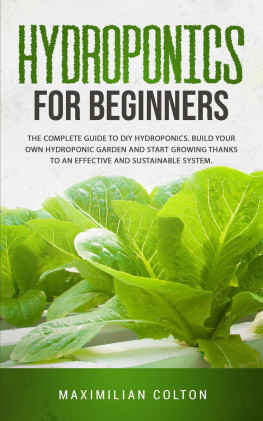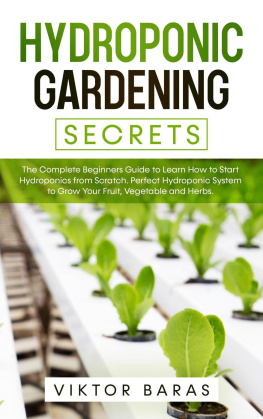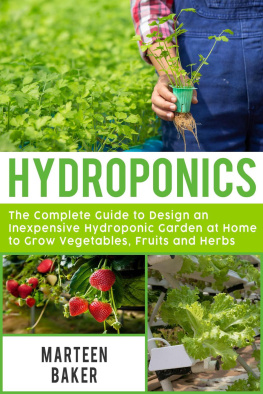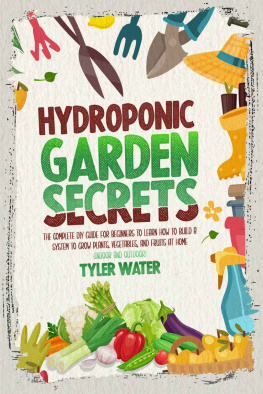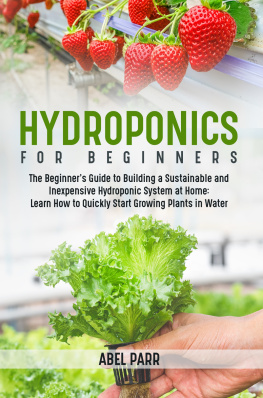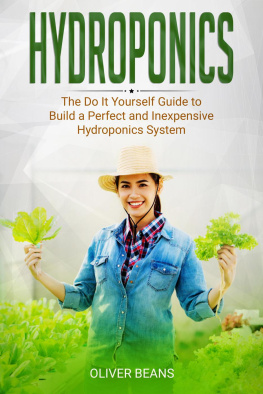Hydroponic Garden
Guide to Start Your Own Hydroponic Garden
Scott Thourson
Copyright 2020 Scott Thourson
All rights reserved
ISBN: 9798657767988
DEDICATION
The author and publisher have provided this e-book to you for your personal use only. You may not make this e-book publicly available in any way. Copyright infringement is against the law. If you believe the copy of this e-book you are reading infringes on the author's copyright, please notify the publisher at: https://us.macmillan.com/piracy
Contents
What Is Hydroponics?
Hydroponics is a type of Horticulture and a subset of hydroculture, which is a method of growing plants without soil, by using mineral nutrient solutions in a water solvent Terrestrial plants may be grown with only their roots exposed to the nutritious liquid, or the roots may be physically supported by an inert medium such as perlite, gravel, or other substrates. Despite inert media, roots can cause changes of the rhizosphere pH and root exudates can impact the rhizosphere biology.
The nutrients used in hydroponic systems can come from many of different sources, including (but not limited to) fish excrement, duck manure, purchased chemical fertilisers, or artificial nutrient solutions.
Plants commonly grown hydroponically, on inert media, include tomatoes, peppers, cucumbers, lettuces, marijuana, and model plants like Arabidopsis thaliana .
Hydroponics offers many advantages, one of them being a decrease in water usage for agriculture. To grow 1 kilogram (2.2 lb) of tomatoes using intensive farming methods requires 400 liters (88 imp gal; 110 U.S. gal) of water; ] using hydroponics, 70 liters (15 imp gal; 18 U.S. gal); and only 20 liters (4.4 imp gal; 5.3 U.S. gal) using aeroponics. Since it takes much less water to grow produce, it could be possible in the future for providers in harsh environments with little accessible water to grow their own food.
History
The earliest published work on growing terrestrial plants without soil was the 1627 book Sylva Sylvarum or 'A Natural History' by Francis Bacon, printed a year after his death. Water culture became a popular research technique after that. In 1699 John Woodward published his water culture experiments with spearmint. He found that plants in less-pure water sources grew better than plants in distilled water. By 1842, a list of nine elements believed to be essential for plant growth had been compiled, and the discoveries of German botanists Julius von Sachs and Wilhelm Knop, in the years 18591875, resulted in a development of the technique of soilless cultivation. Growth of terrestrial plants without soil in mineral nutrient solutions was called solution culture. It quickly became a standard research and teaching technique and is still widely used. Solution culture is now considered a type of hydroponics where there is an inert medium.
Around the 1930s plant scientists investigated diseases of certain plants, and thereby observed symptoms related to existing soil conditions. In this context, water culture experiments were undertaken with the hope of delivering similar symptoms under controlled conditions. In 1929, William Frederick Gericke (August 30, 1882 September 29, 1970) of the University of California at Berkeley began publicly promoting that solution culture be used for agricultural crop production. He first termed it aquaculture but later found that aquaculture was already applied to culture of aquatic organisms. Gericke created a sensation by growing tomato vines twenty-five feet (7.6 metres) high in his back yard in mineral nutrient solutions rather than soil. He introduced the term hydroponics, water culture, in 1937, proposed to him by W. A. Setchell, a phycologist with an extensive education in the classics. Hydroponics is derived from neologism (derived from Greek =water and =cultivate), constructed in analogy to (derived from Greek =earth and =cultivate), geoponica, that which concerns agriculture, replacing, -, earth, with -, water.
Unfortunately, Gericke underestimated that the time was not yet ripe for the general technical application of hydroponics. Reports of Gericke's work and his claims that hydroponics would revolutionize plant agriculture prompted a huge number of requests for further information. Gericke had been denied use of the University's greenhouses for his experiments due to the administration's skepticism, and when the University tried to compel him to release his preliminary nutrient recipes developed at home he requested greenhouse space and time to improve them using appropriate research facilities. While he was eventually provided greenhouse space, the University assigned Hoagland and Arnon to re-evaluate Gericke's claims and show his formula held no benefit over soil grown plant yields, a view held by Hoagland. In 1940, Gericke published the book, Complete Guide to Soilless Gardening, after leaving his academic position in 1937 in a climate that was politically unfavorable. Therein, for the first time, he published his basic formula involving the macro- and micronutrient salts for hydroponically-grown plants. [
As a result of research of Gericke's claims by order of the University of California, Dennis Robert Hoagland and Daniel Israel Arnon wrote a classic 1938 agricultural bulletin, The Water Culture Method for Growing Plants Without Soil, which made the claim that hydroponic crop yields were no better than crop yields with good-quality soils. Ultimately, crop yields would be limited by factors other than mineral nutrients, especially light. However, this study did not adequately appreciate that hydroponics has other key benefits including the fact that the roots of the plant have constant access to oxygen and that the plants have access to as much or as little water as they need. This is important as one of the most common errors when growing is overwatering and underwatering; and hydroponics prevents this from occurring as large amounts of water, which may drown root systems in soil, can be made available to the plant, and any water not used, is drained away, recirculated, or actively aerated, thus, eliminating anoxic conditions. In soil, a grower needs to be very experienced to know exactly how much water to feed the plant. Too much and the plant will be unable to access oxygen; too little and the plant will lose the ability to transport nutrients, which are typically moved into the roots while in solution. Hoagland's views and helpful support by the University prompted these two researchers to develop several new formulas for mineral nutrient solutions, universally known as Hoagland solution. Modified Hoagland solutions will continue to be used, as will the hydroponic techniques proposed by Gericke. [
One of the earliest successes of hydroponics occurred on Wake Island, a rocky atoll in the Pacific Ocean used as a refueling stop for Pan American Airlines. Hydroponics was used there in the 1930s to grow vegetables for the passengers. Hydroponics was a necessity on Wake Island because there was no soil, and it was prohibitively expensive to airlift in fresh vegetables.
From 1943 to 1946, Daniel I. Arnon served as a major in the United States Army and used his prior expertise with plant nutrition to feed troops stationed on barren Ponape Island in the western Pacific by growing crops in gravel and nutrient-rich water because there was no arable land available.
In the 1960s, Allen Cooper of England developed the Nutrient film technique. The Land Pavilion at Walt Disney World's EPCOT Center opened in 1982 and prominently features a variety of hydroponic techniques.
In recent decades, NASA has done extensive hydroponic research for its Controlled Ecological Life Support System (CELSS). Hydroponics research mimicking a Martian environment uses LED lighting to grow in a different color spectrum with much less heat. Ray Wheeler, a plant physiologist at Kennedy Space Center's Space Life Science Lab, believes that hydroponics will create advances within space travel, as a bioregenerative life support system.


